About 75% of small fabrication shops charge between $50 and $65 per hour, which gives you a quick baseline for budgeting, but it’s only part of the picture. You’ll need to factor in minimum call-out fees, material and consumable costs, and whether TIG, MIG or stick welding is required, because each changes labor and prep time. Keep going — understanding these variables will let you compare accurate quotes and avoid surprises.
Welder Hourly Rates and Minimum Charges
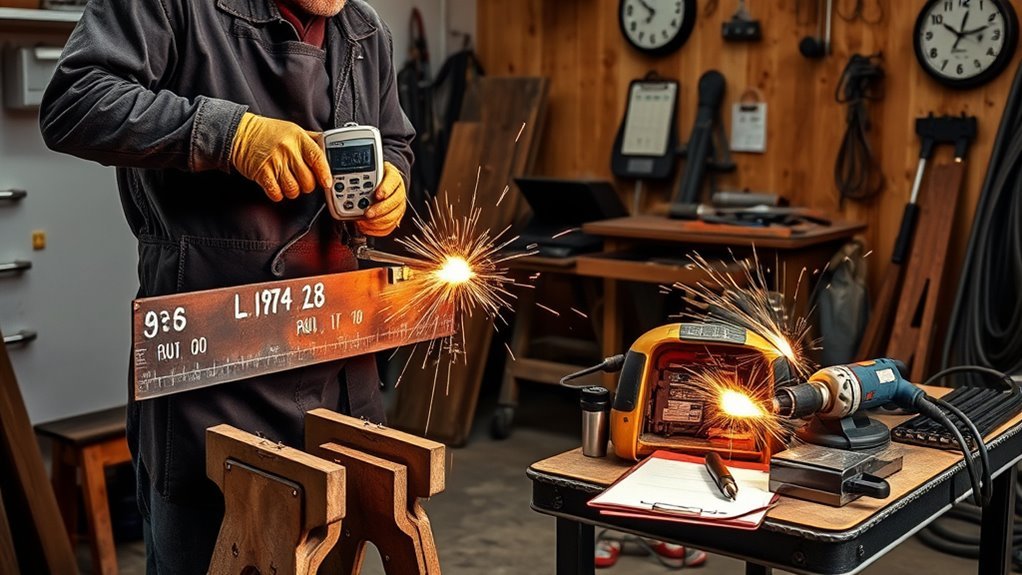
Curious how much you’ll pay for a welding job? You’ll map pricing like a function: national hourly rates typically return values between $50 and $65, while specialized operations can spike to $200/hour.
Many pros enforce minimum service fees—commonly a $75 baseline for the first hour on mobile calls—so your cost model must include that constant. For small MIG tasks expect minimum charges near $40; TIG minima start at $75 due to higher material and setup overhead.
Some shops apply a $60 flat fee to fire up welding equipment, then bill $60/hour afterward—treat that as startup + hourly variables. For larger fabrications, quotes can diverge by over $200 depending on scope; model those as parameterized estimates rather than fixed constants.
When you calculate a job, sum startup fees, minimums, and hourly components, then validate against specialized-rate ceilings to verify your estimate reflects both baseline service fees and potential premium labor.
What Influences the Price to Hire a Welder

You’ll see three main variables that determine the final bill: labor hourly rates, material selection costs, and project complexity level.
Use the national rate range ($50–$65/hr, up to $200/hr for specialists) as your baseline, then factor material multipliers (aluminum or stainless ≈1.5–2× steel) and any minimum or urban premium.
Break the project into discrete tasks and estimate hours per task so you can quantify how complexity scales total cost.
Labor Hourly Rates
Expect to pay roughly $50–$65 per hour for a typical welder, with specialized work pushing rates toward $200/hour. That hourly figure reflects measurable variables you can control or predict—operator experience and certifications, local market rates, shop overhead and minimum service fees, project complexity and scale, and current demand for welding services.
When budgeting, break costs into variables: base hourly rate (geo-adjusted by geographic location), skill premium (years, welding certifications, specialty processes), complexity multiplier (fit-up difficulty, access, fixturing), and fixed fees (minimum call-out, travel, consumables allocation).
Query providers for line-item estimates and rate tables; compare urban vs. rural bids since competition and overhead skew prices. Use this modular approach to model and validate labor hourly cost assumptions.
Material Selection Costs
Because material choice drives both raw cost and process demands, plan your budget around metal type, thickness, and consumable specs—steel is cheapest, while aluminum and stainless typically add 1.5–2× to material costs and often require different filler, shielding gas, and joint preparation.
You’ll log unit prices (e.g., 25′ stick of 2×6 14‑gauge steel at $44–$50) and track market volatility to forecast spend.
Account for consumables: flux, wire, and gas recur — expect $120–$150 every 1.5–2 weeks for active jobs.
Increase estimates for greater metal thickness; thicker sections need heat control, slower passes, and more filler, raising labor and consumable usage.
Specify material quality and approved filler/shielding in the job spec to avoid scope creep and price disputes.
Project Complexity Level
While simpler butt or fillet welds can be quoted as straightforward hourly work, project complexity quickly raises the price because it multiplies required skills, setup time, and specialized consumables. You’ll evaluate welding techniques and project specifications to estimate labor, tooling, and prep. TIG or Flux-Cored processes demand higher hourly rates (up to $200) for precision and control. Thicker sections or exotic alloys add time for heat control, joint fit-up, and post-weld treatment. Urban location and market demand shift rates upward. Factor explicit line items: specialized equipment rental, shielding gases, and bolt-on fixtures. Use a checklist-driven quote to avoid scope creep and unexpected costs.
| Factor | Impact |
|---|---|
| Technique | Hourly rate |
| Material | Prep time |
| Location | Market rate |
| Equipment | Consumables & rental |
Material Costs and Consumables
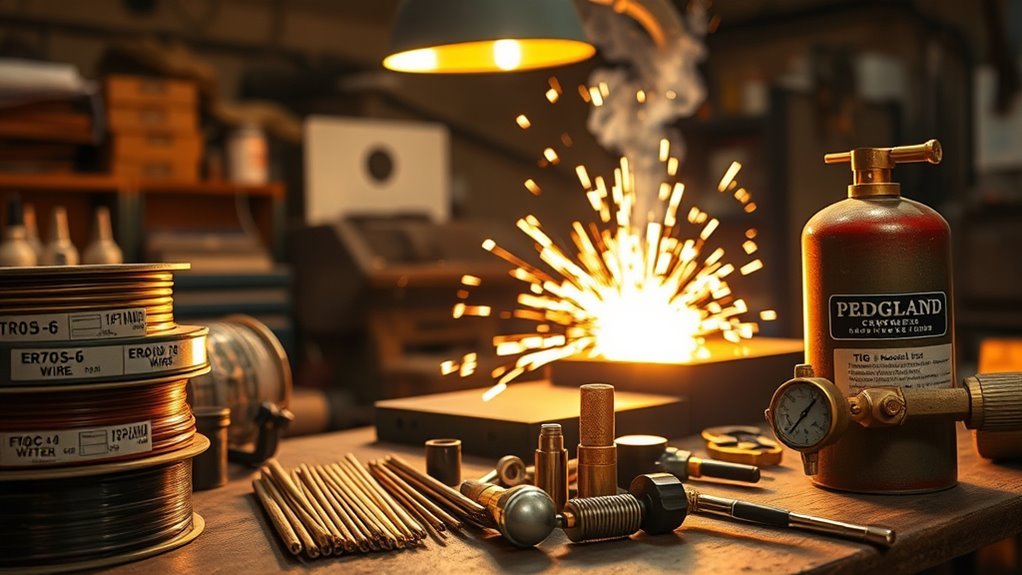
You’ll need to budget for consumables and precise pricing: flux or shielding gas runs about $120–$150 every 1.5–2 weeks, welding wire roughly $40 per 30 lb roll, and sanding paper about $64 per week.
Account for shielding gas consumption rates and material wastage—expect 10–20% extra metal and higher costs for aluminum or stainless (1.5–2× steel).
Use quality filler materials where needed, since their higher unit cost often reduces rework and overall project expense.
Consumables and Pricing
When you break down a welding job’s true cost, consumables — welding rods/wire, shielding gas or flux, abrasives, and PPE — often drive margins more than labor or machine time.
You should model consumable efficiency and material budgeting as discrete variables: wire at ~$40 per 30 lb roll, flux/gas cycles costing $120–$150 every 1.5–2 weeks, and weekly sanding supplies near $64.
Encode metal selection multipliers: steel = 1.0, aluminum/stainless = 1.5–2.0. Include tooling and PPE as fixed-line items per job.
Track consumption rates (units/hour), reorder points, and per-unit cost to compute realistic job quotes. Recalculate pricing when usage or supplier costs change; small percentage shifts in consumables can flip project profitability quickly.
Shielding Gas Needs
Because shielding gas both protects the weld pool and directly drives recurring costs, you should treat gas selection and consumption as line-item variables in job estimating.
You’ll pick argon, helium, CO2, or blends based on process, weld quality targets, and cost efficiency. Plan refill cadence—typically $120–$150 per tank every 1.5–2 weeks depending on use—and model flow rates per weld hour.
- Specify gas type per procedure: pure gases vs. specialized blends.
- Quantify consumption: flow L/min × weld hours → refill schedule.
- Budget sensitivity: price fluctuations affect project margins.
- Quality vs. cost: higher-priced blends may reduce rework and increase cost efficiency.
Document assumptions (flow, hours, price) in estimates so you can audit and adjust real usage.
Material Wastage Rates
Although small on each joint, material wastage compounds quickly, so you should model a 5–20% loss factor by material type and job complexity when estimating costs. You’ll account for consumables (rods, filler, shielding gas, tungsten) and higher-loss exotic alloys. Use material efficiency practices and clear wastage reduction strategies: plan cuts, optimize bead runs, specify higher-quality consumables when they reduce rework, and track scrap rates per lot.
| Item | Typical impact |
|---|---|
| Consumables | 5–15% cost add |
| Exotic alloys | 10–20% cost add |
Quantify: log weight in/out, calculate loss% = (used−net)/used, and feed that into your cost model to keep estimates precise and auditable.
How Metal Type Affects Project Pricing
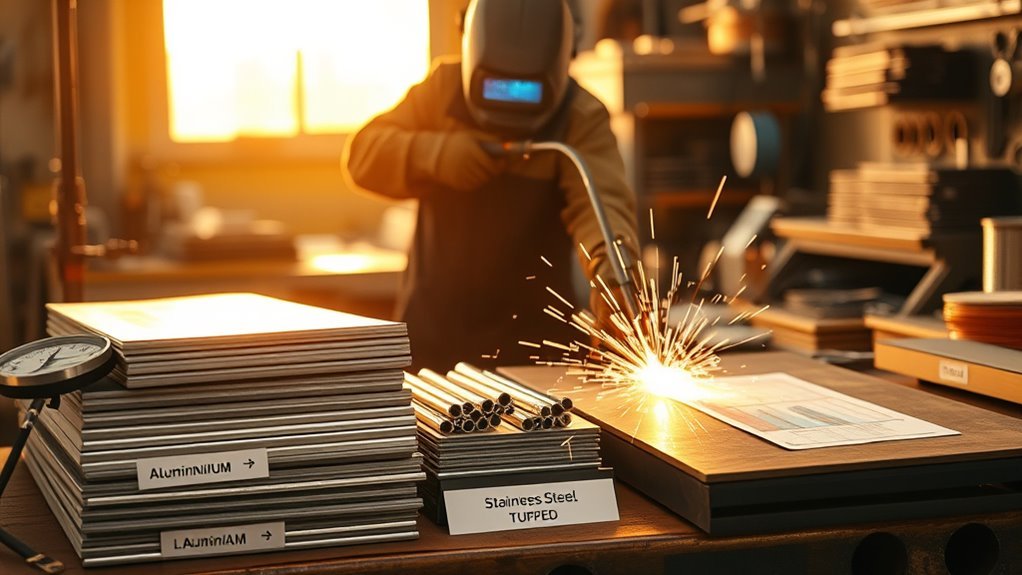
If you pick steel for a project, you’ll usually keep costs low, while choosing aluminum or stainless can bump material and labor expenses by roughly 1.5–2× due to higher base prices and more demanding welding procedures.
You should quantify costs by tracking metal weight and alloy properties upfront: a 25-foot stick of 2×6 14-gauge steel at $44–$50 sets a baseline, but market swings will change that baseline and downstream labor estimates.
Choose alloys and thicknesses deliberately; exotic or thicker materials force specialty procedures, preheat, or slower travel speeds, increasing hours billed.
- Material: base metal unit price and market volatility
- Consumables: filler rods/wire and shielding differences by metal
- Process: welding technique, prep, and post-heat requirements
- Labor: skill level required and time per weld (linked to alloy properties)
Model cost as: material_cost + consumables + process_time * hourly_rate, updating inputs when steel prices shift.
Pricing for Small Repairs and Mobile Jobs

Expect minimums when you call for small repairs or mobile welding: most shops charge a base to cover travel and setup (commonly $75 for the first hour or a $60 fire‑up fee plus $60/hr thereafter), with basic MIG work often quoted around $40 minimum and TIG starting near $75 due to higher consumable and time costs. You’ll plan projects by time+materials; small job pricing and mobile service fees control the baseline.
| Item | Typical Minimum | Notes |
|---|---|---|
| Mobile fire‑up | $60 | One‑time for on‑site start |
| Hourly (mobile) | $60/hr | After fire‑up or instead of $75 first hour |
| MIG minimum | $40 | Low consumables, fast setup |
| TIG minimum | $75 | Higher consumables, slower pace |
| Estimation basis | Time + materials | Location affects rates |
You’ll request clear line items: travel/setup, hourly labor, weld type, and consumables. Use the table to compare predictable cost drivers and avoid surprises by confirming mobile service fees and minimums before work begins.
Welding Methods and Their Cost Differences

When you choose a welding method, you’re directly affecting labor rates, consumable usage, and turnaround time, so pick by material, joint type, and required finish.
You’ll perform a concise cost analysis by matching Welding techniques to project constraints:
Stick (SMAW) is versatile and affordable (~$50–$65/hr) for outdoor and repair work;
Stick (SMAW) — versatile, affordable welding ideal for outdoor and repair work at roughly $50–$65/hr
MIG offers speed and lower labor on routine joints (~$50–$65/hr);
TIG yields high-quality welds but costs more due to skill and time (up to ~$200/hr);
FCAW increases material consumption and can raise total costs for heavy fabrication;
SAW targets thick-plate structural work and typically requires a detailed estimate due to process complexity.
- Stick (SMAW): robust, low hourly cost, good outside
- MIG: fast, efficient, lower labor per weld
- TIG: precision, high hourly rate, specialized
- FCAW/SAW: high deposition or heavy-plate, higher material and process costs
Use this code-like mapping to perform an objective cost analysis when selecting a method.
Estimating Time, Labor, and Overhead
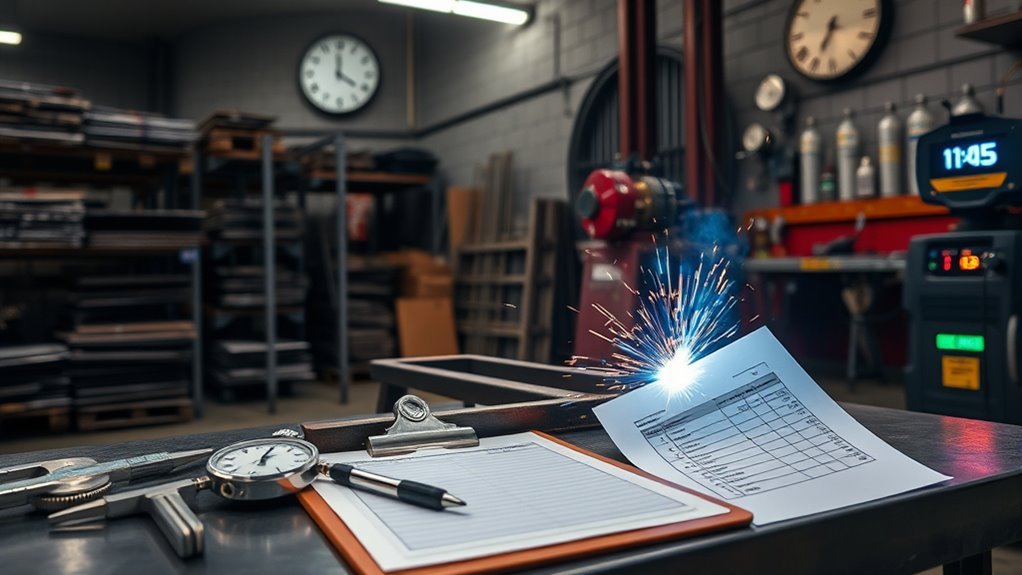
Although precise estimates depend on job specifics, you should plan labor as the dominant cost driver—typically about 85% of total welding expenses—because that figure captures welding time plus prep and cleanup.
Use an hourly welder rate between $50 and $125 (adjustable for certification and complexity), multiply by expected productive hours per joint or assembly, then add overhead line items (equipment operation, shop burden, consumables) and any mobile-service premiums for travel and setup to arrive at a realistic job price.
Break the job into measurable tasks, assign productive-hour estimates, and include setup/tear-down per assembly. Targeting three-hour jobs often optimizes welding efficiency versus administrative overhead.
Quantify consumables per linear inch or per weld, add equipment depreciation per hour, and allocate shop burden as a percentage of labor. For mobile work, model trip time and minimum charges explicitly.
Combine these elements into a simple spreadsheet to generate consistent project timelines and margin-aware quotes.
Tips for Hiring and Vetting a Welder

Because the quality and cost of a welding job hinge on the welder you hire, get a written, itemized estimate with photos and project specs before any work starts; you’ll use that as a baseline to compare skill, timeline, and price.
Verify welding experience specific to your materials and methods — specialized TIG or structural steel work needs documented credentials. Check licenses and certifications against industry standards and confirm insurance.
- Request a free estimate with project specifics and photos to guarantee accurate pricing.
- Confirm certifications, licenses, and verifiable welding experience for the technique required.
- Review customer feedback and examples of completed jobs that match your scope and tolerance.
- Compare hourly rates ($50–$200) against complexity, turnaround, and documented workmanship.
Treat the estimate like code: it must be reproducible, versioned, and include acceptance criteria (weld quality standards, inspection points).
Don’t hire without traceable references and signed scope.
Budgeting for Equipment, Training, and Hidden Costs
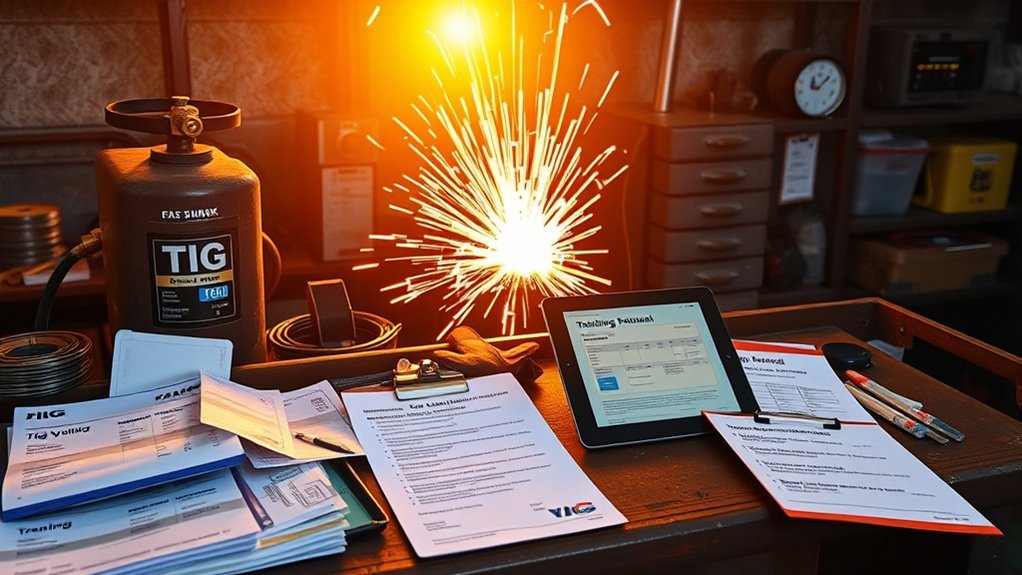
If you’re budgeting for welding work, break costs into discrete, auditable line items—equipment (machines, torches, PPE), consumables (electrodes, filler, shielding gas), training and certifications, and recurring overhead (electricity, gas refills, maintenance, waste disposal)—so you can version and compare estimates consistently.
Treat training costs as a capital decision: programs run $2,000–$15,000 and take six months to two years, so amortize certification expense over expected billable hours. Model labor and overhead as ~85% of total cost; include prep, post-weld cleanup, and inspection time.
Itemize ongoing consumables (tungsten, filler metals) and gas refill frequency; calculate unit cost × monthly usage. Include electricity metering for high‑usage machines and forecast kWh × rate.
Add periodic equipment maintenance and planned repairs as a line with a reserve percentage (e.g., 3–7% of equipment value/year). Track membership discounts (associations) as cost offsets.
Produce versioned cost sheets, run sensitivity analysis on key drivers, and update quarterly.
Frequently Asked Questions
Can Welding Affect Nearby Paint, Glass, or Electronics?
Yes — welding can harm paint, glass, and electronics, so you’ll use welding precautions like shielding, heat sinks, and grounding; follow damage prevention checklists, verify clearances, and isolate sensitive components to prevent heat, spatter, and EMI-induced failures.
Do Welders Carry Insurance for Accidental Property Damage?
Yes — like a sudden spark lighting a ledger, you’ll find many welders carry insurance coverage. You’ll want written proof; it handles liability claims, outlines limits, deductibles, and policy conditions so you can verify protections precisely.
Can Welding Be Done in Extreme Weather Conditions?
Yes — you can weld in extreme conditions, but you’ll adjust welding techniques and mitigate weather impacts: you’ll choose suitable processes, control preheat/postheat, secure shielding gases, manage wind/rain, and follow strict safety and inspection protocols.
Are Permits or Inspections Required for My Welded Project?
Yes — think of your project as a ship needing clearance: you’ll follow welding regulations, request inspections, and budget permit costs. You’ll submit plans, meet code specifics, schedule checks, and document compliance precisely and promptly.
How Long Does a Professional Weld Typically Last Without Maintenance?
A professional weld typically lasts decades without maintenance if weld quality is high; you’ll see 20–50 years depending on materials and environment, so maintenance frequency can be low, scheduled based on inspections and corrosion risk.
Conclusion
You’ll want a clear estimate before sparks fly — think of costs like a blueprint: hourly rates ($50–$65 standard, up to $200 specialized), minimum fees (often $75+), plus metals, consumables, travel, and complexity that stitch the final total. Pin down material type and method, vet credentials, and account for hidden overhead. Treat each quote like code: read every line, test assumptions, and don’t deploy until the logic and budget both compile.


